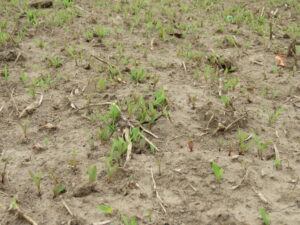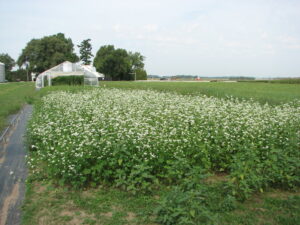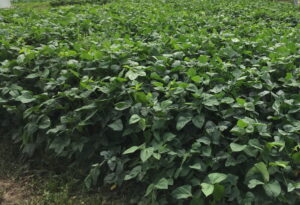As spring crops finish up, areas where no crop is planned for a month or more are good candidates for a summer cover crop. A number of species reliably establish well in the summer. The best one for a particular situation will depend on the length of time available, the desired benefits, and the following crop. Three examples used in Indiana are provided here.
Sorghum-sudangrass and sudangrass are both excellent for building soil and very competitive against weeds. They can grow to 8 ft. tall. If that much height isn’t desirable, they can be mowed one or more times. They can be flail mowed and mechanically incorporated while still green. If left to grow they will be killed by frost and form a thick mat of residue. When ground will be open 6 to 8 weeks or more these crops can be a good fit. Broadcast seed at 40-50 lbs/A or drill at 35-40 lbs/A.
Buckwheat is ranked very good for soil building and excellent for fighting weeds. It germinates, establishes, and flowers quickly, sometimes as soon as three weeks, so is a great choice when there are just a few weeks of cover needed. The flowers attract beneficial insects and pollinators. However, if seed matures it can germinate to become a weed in a future crop. To avoid this, terminate within 7 to 10 days after flowering begins. Many producers report that buckwheat leaves the soil in excellent condition prior fall crops of greens. It breaks down quickly once killed. It will be killed by frost. Broadcast at 96 lbs/A and incorporate into soil, or drill at 50-60 lbs/A.
Cowpea is ranked good for soil building and fighting weeds, but as a legume, ranks very good for fixing nitrogen. It may fix 50 to 120 lbs N/A. It is a good crop for hot, dry weather. The plants attract a variety of beneficial insects. Many varieties of this crop are grown for human consumption, and known as southern pea, crowder pea, or black-eyed pea. Viny types are best for cover crops. Bloom occurs 60 to 90 days depending on variety. Cowpea will break down and release nutrients most quickly if incorporated while still green. Mowing or rolling can be used before incorporating to reduce regrowth. Cowpea will be killed by frost. Broadcast 100 lbs/A and till to cover seed, or drill 30-90 lbs/A. To gain benefits of nitrogen fixation, use a rhizobium inoculant meant for cowpea.
Additional options include oats, pearl millet, Japanese millet, crimson clover, and soybean. An excellent resource to learn more about these cover crops as well as others is the Midwest Cover Crops Council at http://mccc.msu.edu. The cover crop decision tool can be used to identify options that fit a desired planting window and address specific goals. Indiana-specific information sheets are available for the various cover crops. The site also includes chapters from Managing Cover Crops Profitably, 3rd Edition, and links to relevant publications from around the Midwest. For small-acreages, the publication Cover Crops in the Home Garden provides seeding rates per 100 sq. ft.


